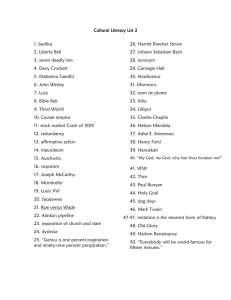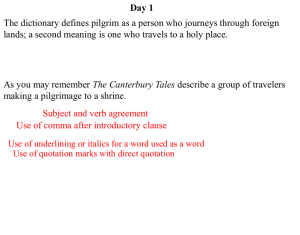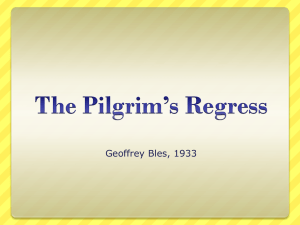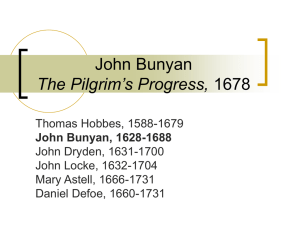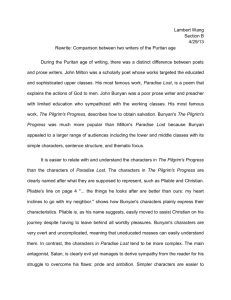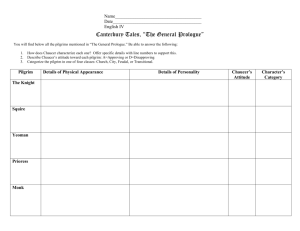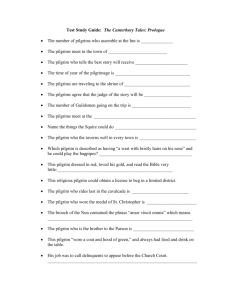The Author's Apology for his Book1
advertisement
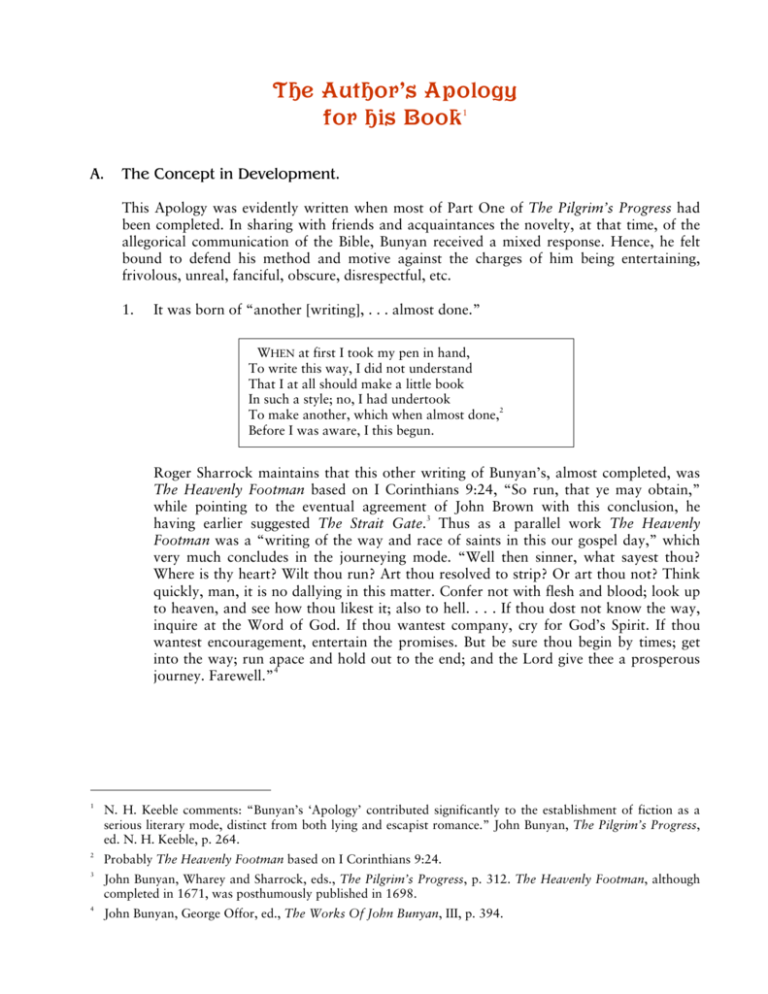
The Author’s Apology for his Book 1 A. The Concept in Development. This Apology was evidently written when most of Part One of The Pilgrim’s Progress had been completed. In sharing with friends and acquaintances the novelty, at that time, of the allegorical communication of the Bible, Bunyan received a mixed response. Hence, he felt bound to defend his method and motive against the charges of him being entertaining, frivolous, unreal, fanciful, obscure, disrespectful, etc. 1. It was born of “another [writing], . . . almost done.” WHEN at first I took my pen in hand, To write this way, I did not understand That I at all should make a little book In such a style; no, I had undertook 2 To make another, which when almost done, Before I was aware, I this begun. Roger Sharrock maintains that this other writing of Bunyan’s, almost completed, was The Heavenly Footman based on I Corinthians 9:24, “So run, that ye may obtain,” while pointing to the eventual agreement of John Brown with this conclusion, he 3 having earlier suggested The Strait Gate. Thus as a parallel work The Heavenly Footman was a “writing of the way and race of saints in this our gospel day,” which very much concludes in the journeying mode. “Well then sinner, what sayest thou? Where is thy heart? Wilt thou run? Art thou resolved to strip? Or art thou not? Think quickly, man, it is no dallying in this matter. Confer not with flesh and blood; look up to heaven, and see how thou likest it; also to hell. . . . If thou dost not know the way, inquire at the Word of God. If thou wantest company, cry for God’s Spirit. If thou wantest encouragement, entertain the promises. But be sure thou begin by times; get into the way; run apace and hold out to the end; and the Lord give thee a prosperous 4 journey. Farewell.” 1 N. H. Keeble comments: “Bunyan’s ‘Apology’ contributed significantly to the establishment of fiction as a serious literary mode, distinct from both lying and escapist romance.” John Bunyan, The Pilgrim’s Progress, ed. N. H. Keeble, p. 264. 2 Probably The Heavenly Footman based on I Corinthians 9:24. 3 John Bunyan, Wharey and Sharrock, eds., The Pilgrim’s Progress, p. 312. The Heavenly Footman, although completed in 1671, was posthumously published in 1698. 4 John Bunyan, George Offor, ed., The Works Of John Bunyan, III, p. 394. THE PILGRIM’S PROGRESS – AN OUTLINED COMMENTARY 26 2. It was born out of Christian journeyings. And so it was: I writing of the way And race of saints in this our gospel day, 5 Fell suddenly into an allegory About their journey, and the way to glory, In more than twenty things, which I set down; This done, I twenty more had in my crown, And they again began to multiply, Like sparks that from the coals of fire do fly. Then no, I thought since if you breed so fast, I’ll put you by yourself, lest you at last Should prove ad infinitum, and eat out The book that I already am about. While Bunyan was a keen observer of the journeyings of other saints, and incorporates these in The Pilgrim’s Progress, yet with regard to the distinctiveness of Christian, he gives preeminence to his own spiritual travels as described in Grace Abounding To The Chief Of Sinners, published earlier in 1666. He found that the numerous elements of his emerging allegory flooded and bubbled into his soul, “like sparks that from the coals of fire do fly.” On account of this he feared that he would not complete The Heavenly Footman. 3. It was born out of self-interest. Well, so I did; but yet I did not think To show to all the world my pen and ink In such a style; I only thought to make I knew not what, nor did I undertake Thereby to please my neighbor; no, not I, I did it my own self to gratify. This prisoner did not aspire to attain world-wide literary fame, monetary gain, or approval from his pastoral peers, but simply self-gratification born of a creative frame of mind. It was a novel, biblical, literary challenge to his fertile imagination. 5 Bunyan also refers to his allegorical style, in this and his concluding poem, as similitude, metaphor, parable, figure, type, fable, and shadow. THE AUTHOR’S APOLOGY 4. 27 It was born out of prison activity. Neither did I but vacant seasons spend In this my scribble; nor did I intend But to divert myself in doing this, From worser thoughts which make me do amiss. Thus I set pen to paper with delight, And quickly had my thoughts in black and white. For having now my method by the end [tail], 6 Still as I pulled it came, and so I penned It down, until it came at last to be For length and breadth the bigness that you see. In keeping with the Puritan dislike for slothfulness, Bunyan confesses his aversion to those “vacant seasons” that prison life readily provided. Hence, he wrote with energetic devotion, as a diversionary tactic, so that he might avoid the contemplation of carnal thoughts and actions. So he spun pictures of truth with words, like a woman at 7 her spinning-wheel, for in alluding to this craft, he writes, “as I pulled it came,” and thus there developed a sizeable volume. Further proof of this holy zeal in prison is not only his writing of a total of twelve books and tracts there, but also his counseling, preaching, carving a flute out of a chair-leg, and, to support his family, “making many 8 hundred gross of long Tagg’d laces to fill up the vacancies of his time.” B. The Conflict in Publishing. Assuming that the manuscript of The Pilgrim’s Progress was sufficiently complete by the 9 time of Bunyan’s release from prison in 1672, the fact that publication was delayed until 1678 strongly suggests some degree of hesitancy on Bunyan’s part. Well, when I had thus put my ends together, I showed them others, that I might see whether They would condemn them, or them justify: And some said, “Let them live”; some, “Let them die”; Some said, “John, print it”; others said, “Not so”; Some said, “It might do good”; others said, “No”. 6 Bunyan is probably alluding to a woman pulling thread from a spinning-wheel. 7 Ibid., p. 312. 8 John Brown, John Bunyan, p. 160. 9 While John Brown believed that The Pilgrim’s Progress was composed during Bunyan’s second major imprisonment, the six month period of 1676-77, John Bunyan, pp. 239-48, the evidence provided by Sharrock, John Bunyan, Wharey and Sharrock, eds., The Pilgrim’s progress, pp. xxix-xxxv, supported by George Offor, N. H. Keeble, Christopher Hill, as well as the opinions of the earlier writers and acquaintances of Bunyan, seems to strongly confirm the alternative view that the allegory was written during the latter years of the long 12 year imprisonment. THE PILGRIM’S PROGRESS – AN OUTLINED COMMENTARY 28 1. Some were in agreement. George Offor relates how Bunyan read The Pilgrim’s Progress to his fellow prison inmates and sought their opinion of it. One prisoner, a Pastor Thomas Marsom of Luton, at first expressed his disapproval. But upon closer examination of the complete 10 manuscript in his own cell, he earnestly recommended it for publication. Also Dr. John Owen was undoubtedly of the same favorable opinion since Bunyan used his publisher in this instance, namely Nathaniel Ponder. 2. Some were in disagreement. Other friends of Bunyan voiced serious opposition believing that The Pilgrim’s Progress would excite a trifling and light-hearted attitude that would be unbecoming to the nature of sacred truth. Hence most likely, out of respect, the manuscript was pigeon11 holed for several years. Now was I in a straight [plight], and did not see Which was the best thing to be done by me; At last I thought, since you are thus divided, I will print it, and so the case decided. For, thought I, some I see would have it done, Though others in that channel do not run. To prove then who advised for the best, Thus I thought fit to put it to the test. I further thought, if now I did deny Those that would have it thus, to gratify, I did not know, but hinder them I might, Of that which would to them be great delight. For those that were not for its coming forth, I said to them, “Offend you I am loath; Yet since your brethren pleased with it be. Forbear to judge till you do further see.” If that you will not read, let it alone; Some love the meat, some love to pick the bone: Yes, that I might them better palliate, I did too with them thus expostulate. 3. The only valid test was to print. As if applying the “Gamaliel test” of Acts 5:38-39, Bunyan opts for putting The Pilgrim’s Progress on trial before divine providence and public response. He asks opponents to “forbear to judge, till you do further see,” and commences to offer a rationale for his purpose. 10 Bunyan, Works, III, p. 7. 11 Ibid., p. 8. THE AUTHOR’S APOLOGY C. 29 The Illustrations in Support. Here is further evidence of Bunyan’s acute sense of perception with regard to the creation and nature, in this instance concerning clouds, fish, birds, and pearls. Refer also to the 12 various emblems described in A Book For Boys And Girls. 1. The fruitfulness of dark and bright clouds. Just ahead in the text, Bunyan mentions the particular criticism of The Pilgrim’s Progress being “dark” or “feigned,” that is fictional and imaginary rather than easily intelligible. So he illustrates that the rain of dark clouds is especially fruitful. But whatever type a cloud may be, even bright, if it is productive, then let controversy over the means to this end be put aside. May I not write in such a style as this? In such a method too, and yet not miss Mine end, your good? Why may it not be done? Dark clouds bring waters, when the bright bring none; Yes, dark or bright, if they their silver drops Cause by descent, the earth to yielding crops, Give praise to both, and carpeth [censure] not at ither, But treasure up the fruit they yield together; Yes, so combine them both, that in her fruit None can distinguish this from that, they suit Her well when hungry; but if she be full She spews out both, and makes their blessings null. 2. The skill of the cunning fisherman. You see the ways the fisherman does take To catch the fish, what engines he does make? Behold! how he engages all his wits, Also his snares, lines, angles, hooks and nets. Yet fish there be, that neither hook nor line, Nor snare, nor net, nor engine can make thine; They must be groped for, and be tickled too, 13 Or they will not be caught, whate’er you do. The allusion here is probably to the poacher’s deft method in stroking a fish and then suddenly snatching it from the water. In this suggestion of Matthew 4:19, Calvinist Bunyan gives a lesson concerning responsibility in evangelism. A great catch of fish takes ingenuity and a consideration of a variety of possible approaches. The fish themselves are often extremely resistant and must be suitably baited. Thus some obstinate prospects may even need “tickling,” that is stimulation by a mode such as The Pilgrim’s Progress. Believers in the sovereignty of God ought to ponder the 12 Ibid., pp. 746-762. 13 Matt. 4:19. THE PILGRIM’S PROGRESS – AN OUTLINED COMMENTARY 30 subservient means that He uses in His gracious saving of sinners (Matt. 10:16; Luke 16:9). 3. The craft of the stalking fowler. How does the fowler seek to catch his game? By varied means, all which one cannot name. 14 His gun, his nets, his lime-twigs, light and bell; He creeps, he goes, he stands; yes, who can tell Of all his postures? Yet there’s none of these Will make him master of what fowls he please. Yes, he must pipe, and whistle to catch this; Yet if he does so, that bird he will miss. Again Bunyan justifies evangelistic ingenuity. He would, in certain circumstances, “pipe and whistle” to gain a hearing. But surely a holy end can only be justified by a holy rather than an unholy means. Otherwise, “anything goes” in terms of evangelistic method. This being so, The Pilgrim’s Progress is a good example of a holy means that God has been pleased to bless in a way that has resulted in holy ends, especially the effectual communication of saving truth. 4. The pearl in the oyster-shell. 15 If that a pearl may in a toad’s head dwell, And may be found too, in an oyster-shell; If things that promise nothing, do contain What better is than gold; who will disdain (That have an inkling of it) there to look, That they may find it? Now my little book, (Though void of all those paintings that may make It with this or the other man to take,) Is not without those things that do excel, What do in brave but empty notions dwell. A pearl in a “toad’s head” refers to a mythical belief that certain precious gems were formed in the head of a toad. However, a pearl in an oyster-shell parallels lines from Bunyan’s concluding poem. What of my dross thou findest there, be bold To throw away, but yet preserve the gold; What if my gold be wrapped up in ore? 16 None throws away the apple for the core. 14 Twigs smeared with sticky birdlime used to snare small birds. 15 An allusion to the mythical belief that certain precious gems were formed in the head of a toad. 16 Ibid., p. 167. THE AUTHOR’S APOLOGY 31 Thus Bunyan pleads that, though The Pilgrim’s Progress has no pretty pictures, yet it contains treasure, as if in a tawdry casket, that is well worth discovery through mining and fishing. D. The Objections in Reply. To the unconvinced objector, Bunyan offers further rebuttal, this probably being reflective of his encounter with substantial opposition. 1. It is dark and fictitious. Yes, even as the Bible is at times “dark” in style and lacking in simple clarity (Ps. 78:2), and that on account of God’s purpose (Deut. 29:29), yet from within radiates forth, by means of parabolic and allegorical style, truth that “spangles” with the light of truth and reality. Well, yet I am not fully satisfied, that This your book will stand when soundly tried.” 17 Why, what’s the matter? “It is dark [obscure]”, What though? “But it is feigned [fiction].” What if that is so? Some men by words of fiction, dark as mine, Make truth to spangle, and its rays to shine. 2. It is metaphorical rather than solid. Having been mentioned earlier, this seems to be the principal objection which now receives an extended response. Recall Bunyan’s quotation of Hosea 12:10, “I have used similitudes,” on the title page of The Pilgrim’s Progress. a. But the Bible is metaphorical. But they lack solidness.” Speak man your mind; “They drowned the weak; metaphors make us blind.” Solidity, indeed becomes the pen Of him that writes things divine to men; But must I needs lack solidness, because By metaphors I speak; were not God’s laws, It speaks of allegory, similitude, figure, type, fable, shadow, and metaphors. Shall we then be so bold as to find fault with the Bible? 17 Ps. 78:2. THE PILGRIM’S PROGRESS – AN OUTLINED COMMENTARY 32 b. But the Bible solicits typological investigation. His gospel laws in olden time held forth By types, shadows and metaphors? Yet loath Will any sober man be to find fault With them, lest he be found for to assault The highest wisdom. No, he rather stoops, And seeks to find out what by pins and loops, By calves and sheep, by heifers and by rams, By birds and herbs, and by the blood of lambs; God speaks to him, and happy is he That finds the light and grace that in them be. It invites us to be wise in discovering its metaphorical meaning (I Cor. 10:1-11), such as with regard to “pins and loops” (Ex. 26:5; 27:19) and other typological 18 items. Refer to Bunyan’s Solomon’s Temple Spiritualized. c. But the Bible is metaphorically solid. Be not too forward therefore to conclude That I lack solidness, that I am rude [superficial]; All things solid in show not solid be; All things in parables despise not we, Lest things more hurtful lightly we receive, And things that good are, of our souls bereave. My dark and cloudy words they do but hold The truth, as cabinets enclose the gold. That is, the Bible speaks solid truth in parables, while all things apparently solid are not always stable (Matt. 7:26-27). d. But allegory is like a garment that clothes the truth. The prophets used much by metaphors To set forth truth; yes, who so considers Christ, his Apostles too, shall plainly see, That truths to this day in such garments be. As metaphors clothe the truth of Christ and his apostles, even as wooden cabinets encase gold, so The Pilgrim’s Progress encapsulates the truth of Scripture. 18 Ibid., pp. 460-509. THE AUTHOR’S APOLOGY e. 33 But the Bible is at times dark, figurative, and also illuminating. Am I afraid to say that holy writ, Which for its style and phrase puts down [quells] all wit, Is everywhere so full of all these things, Dark figures, allegories? Yet there springs From that same book that luster, and those rays Of light that turns our darkest nights to days. Yes, the Bible is metaphorical and not even amusing. Nevertheless it also has luster and radiance that dispels human gloom. So The Pilgrim’s Progress likewise illuminates. f. But the critic has a dark side. Come, let my carper [critic] to his life now look, And find there darker lines than in my book He finds any. Yes, and let him know That in his best things there are worse lines too. Even he, as a child of God, has murky depths while at the same time better and more shining qualities as well. So why be more critical of The Pilgrim’s Progress than self? g. But The Pilgrim’s Progress edifies. May we but stand before impartial men, To his poor one, I dare adventure ten, That they will take my meaning in these lines 19 Far better than his lies in silver shrines. 20 Come, truth, although in swaddling-clothes, I find Informs the judgment, rectifies the mind, Pleases the understanding, makes the will Submit; the memory too it does fill With what our imagination does please; Likewise, it tends our troubles to appease. Though metaphorical and “in swaddling clouts [infant or allegorical dress],” yet it builds up and helps the troubled and immature far more than Satan’s “lies in silver shrines [Acts 19:24].” 19 Acts 19:24 20 Infant or allegorical dress. THE PILGRIM’S PROGRESS – AN OUTLINED COMMENTARY 34 3. It is unlike the sound words of Paul. 21 Sound words I know Timothy is to use, 22 And old wives’ fables he is to refuse; But yet grave Paul him nowhere does forbid The use of parables; in which lay hid That gold, those pearls, and precious stones that were Worth digging for, and that with greatest care Yet nowhere does the sober Apostle Paul, who recommends health giving words to Timothy (I Tim. 4:7; II Tim. 1:13), forbid the use of parables, which are in fact such a mine of treasure. E. The Final Defense. Let me add one more word, O man of God! Are you offended? Do you wish I had Put forth my matter in another dress, Or that I had in things been more express? Three things let me propound, then I submit To those that are my betters, as is fit. 23 “O man of God” (I Tim. 6:11) suggests that Bunyan’s objectors were mainly pastors and clergymen, even imprisoned companions, to whom he offers respectful deference. 1. The Pilgrim’s Progress advances excellent truth. 1. I find not that I am denied the use Of this my method, so I no abuse Put on the words, things, readers, or be rude In handling figure, or similitude, In application; but, all that I may, Seek the advance of truth this or that way. Denied did I say? No, I have leave, (Example too, and that from them that have God better pleased by their words or ways, Than any man that breathes nowadays), Thus to express my mind, thus to declare Things unto you that more excellent are. 21 II Tim. 1:13. 22 I Tim. 4:7. 23 I Tim. 6:11. Bunyan’s objectors were most likely pastors. THE AUTHOR’S APOLOGY 35 The style has propriety and taste; so let those who object nevertheless support the cause of truth. Further let none of us be restricted by present literary fashion since the past presents more noble expositors and supporter of this novel expression of the truth. 2. The Pilgrim’s Progress communicates in the accepted mode of dialogue. 2. I find that men, as high as trees, will write Dialogue-wise; yet no man does them slight For writing so; indeed if they abuse Truth, cursed be they, and the craft they use To that intent; but yet let truth be free To make her sallies [charges] upon you and me, Which way it pleases God. For who knows how, Better than he that taught us first to plough, To guide our mind and pens for his design? And he makes base things usher in divine. Of course the abuse of truth ought never to be tolerated. But on the other hand, let truth have freedom to reign and challenge. Let God alone be the guide of our pens. For He who first taught us to plow (Isa. 28:24-26; I Cor. 9:9-10) can still teach us to communicate afresh, even by means of lowly instruments. 3. The Pilgrim’s Progress has some semblance in form with the Bible. 3. I find that holy writ in many places Has likeness with this method, where the cases Do call for one thing to set forth another; Use it I may then, and yet nothing smother Truth’s golden beams; no, by this method may Make it cast forth its rays as light as day. Again, the various instances of allegory, similitude, metaphor, parable, figure, type, fable, and shadow in the Bible are, as a whole, offered as justification for Bunyan’s ground-breaking style in the field of communicating evangelical truth. The intent is not to smother truth, but rather illuminate “truth’s golden beams” in an arresting way like unto a dawning day. F. The Final Commendation. And now before I do put up my pen, I’ll show the profit of my book, and then Commit both you and it unto that hand That pulls the strong down, and makes weak ones stand. The question of practical outworking now supplants the issue of literary style. Bunyan has rare balance between doctrinal integrity and pragmatic flexibility. At this point he is concerned with The Pilgrim’s Progress as an effective medium of the truth of God. THE PILGRIM’S PROGRESS – AN OUTLINED COMMENTARY 36 1. The Pilgrim’s Progress is a plain map of the way of salvation. Here is the reason for the overwhelming popularity of Bunyan’s allegory. Though a committed Calvinist, he saw no inconsistency in a book that “chaulketh [plainly and graphically diagrams] before thine eyes,” the only way to heaven. a. It guides to an everlasting prize. This book it chalks [marks] out before your eyes, 24 The man that seeks the everlasting prize; It shows you whence he comes, where he goes, What he leaves undone, also what he does; It also shows you how he runs and runs, Till he unto the gate of glory comes. The route has a start and destination. Travelers in transit must keep on running 25 until they “obtain . . . the prize” (I Cor. 9:24; Phil. 3:14), that is acceptance at “the gate of glory,” or the Celestial City. b. It guides travelers who abandon the way. It shows too, who sets out for life amain [vigorously], As if the lasting crown they would attain; Here also you may see the reason why They lose their labor, and like fools do die. The map, although accurate, is misinterpreted, neglected, and derided by pilgrims who eventually stumble, defect, and perish. c. It guides to the Holy Land. This book will make a traveler of you, If by its counsel you its rules will do; It will direct you to the Holy Land, If you will its directions understand; This Holy Land, which so excites the hopes of earnest travelers, is heavenly rather than earthly. Only authentic and proven pilgrims finally arrive. 24 I Cor. 9:24; Phil. 3:14. 25 Cf. “The Heavenly Footman,” Bunyan, Works, III, pp. 375-394. THE AUTHOR’S APOLOGY d. 37 It guides from blindness to sight. Yes, it will make the slothful active be, The blind also delightful things to see. The indolent are aroused, the deaf, dumb, and blind receive hearing, speech, and sight, so that a highway is perceived before them (Isa. 35:8). 2. The Pilgrim’s Progress is a stimulus to listlessness. Are you for something rare, and profitable? Would you see a truth within a fable? Are you forgetful? Would you remember From New Year’s day to the last of December? Then read my fancies, they will stick like burs, And may be to the helpless, comforters. This book is writ in such a dialect As may the minds of listless men affect: It seems a novelty, and yet contains Nothing but sound and honest gospel strains. Here Bunyan gives the clearest statement of his purpose in writing The Pilgrim’s Progress. As a pastor, he was only too aware of religious dabblers, that is those who allied themselves with Christianity in general and yet remained casual, indifferent, and apathetic in their nominal faith. Again, Bunyan is not averse to laying bait, so that here he confesses his enticing purpose that is also intended to result in sobering challenge to the soul. a. It entices, intrigues, as “something rare, and profitable.” b. It goads, stimulates, as clinging burs. c. It awakens, arouses curiosity, with novelty. d. It evangelizes, with “sound and honest gospel-strains.” THE PILGRIM’S PROGRESS – AN OUTLINED COMMENTARY 38 G. The Final Invitation. The bait is laid with even more tantalizing effect. Paradox upon paradox is offered as grist for the inquisitive, as a balm for the melancholy. Would you divert yourself from melancholy? Would you be pleasant, yet be far from folly? Would you read riddles and their explanation? Or else be drowned in your contemplation? Do you love picking meat? Or would you view A man in the clouds, and hear him speak to you? 26 Would you be in a dream, and yet not sleep? Or would you in a moment laugh and weep? Would you lose yourself, and catch no harm? And find yourself again without a charm? Would read yourself, and read you know not what And yet know whether you are blest or not, By reading the same lines? Oh then come hither, And lay my book, your head and heart together. JOHN BUNYAN 1. Search for the paradox of reality in an allegory. Though pleasant, yet it is wise; though a puzzle, yet it is solvable; though a dream, yet it is for those who are awake; though amusing, yet it brings tears; though a critique of self, yet it establishes self; though a book to be read, yet it reads the reader. 2. Search my book with head and heart. Both the mind, in comprehending the truth of God, and the heart, in embracing the truth of God, are to be employed if the paradox is to be satisfactorily resolved. 26 Search for the paradox of reality in an allegory. THE AUTHOR’S APOLOGY The Sleeping Portrait Engraved by Robert White, it was most likely intended for the first edition of 1678, though withdrawn due to the name ‘Destruction’ being incorrectly titled ‘Vanity’. The above corrected picture was included in the third edition of 1679. 39
